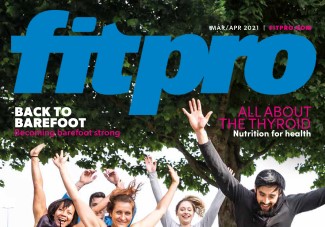Magazine References
Mar – Apr 2021

Load it up – Applying loaded movement training
References
1. Gray Institute GIFT programme
2. Dr Gary Gray (personal conversations)
3. BioFlow seminar, Dr Andreo Spina FRS
4. Institute of motion mentorship
5. Institute of motion mentorship
6. Poloquin strength training principles
7. Myers T (2020), Anatomy Trains: Myofascial Meridians for Manual Therapists and Movement Professionals, 4th edition.
8. FRC certification (FRS)
9. Bosch F, Klomp R (2004), Running: Biomechanics and Exercise Physiology in Practice.
10. Bosch F, Klomp R (2004), Running: Biomechanics and Exercise Physiology in Practice.
11. Schleip R (2012), Fascia: The Tensional Network of the Human Body: The science and clinical applications in manual and movement therapy.
12. ViPR certification/manual
Pg 18-19 Taking it outdoors
References
1. Thompson Coon J, Boddy K, Stein K, Whear R, Barton J, Depledge MH (2011), Does participating in physical activity in outdoor natural environments have a greater effect on physical and mental wellbeing than physical activity indoors? A systematic review, Environmental Science & Technology, 45(5), 1761-1772. doi: http://dx.doi.org/10.1021/es102947t, accessed on 19 January 2021.
2. Park BJ, Tsunetsugu Y, Kasetani T, Kagawa T, Miyazaki Y (2011), The physiological effects of Shinrin-yoku (taking in the forest atmosphere or forest bathing): Evidence from field experiments in 24 forests across Japan, Environmental Health Preventative Medicine, 15(1), 18-26. doi: https://pubmed.ncbi.nlm.nih.gov/19568835/, accessed on 19 January 2021.
3. Ocobock CJ (2017), Body fat attenuates muscle mass catabolism among physically active humans in temperate and cold high altitude environments, Am J Hum Biol, 10: 29(5). doi: https://doi.org/10.1002/ajhb.23013, accessed on 19 January 2021.
Pg 22-24 ‘SCRIPT’: A football case study
References
1. Mohr M, Krustrup P, Bangsbo J (2003), Match performance of high-standard soccer players with special reference to development of fatigue, Journal of Sports Sciences, 21(7): 519-28.
2. Carling C, Bloomfield J, Nelsen L, Reilly T (2008), The role of motion analysis in elite soccer, Sports Medicine, 38(10): 839-62.
3. Mallo J, Mena E, Nevado F, Paredes V (2015), Physical demands of top-class soccer friendly matches in relation to a playing position using global positioning system technology, Journal of Human Kinetics, 47(1): 179-88.
4. Manson SA, Brughelli M, Harris NK (2014), Physiological characteristics of international female soccer players, The Journal of Strength & Conditioning Research, 28(2): 308-18.
5. Faude O, Koch T, Meyer T (2012), Straight sprinting is the most frequent action in goal situations in professional football, Journal of Sports Sciences, 30(7): 625-31.
6. Ozbar N, Ates S, Agopyan A (2014), The effect of 8-week plyometric training on leg power, jump and sprint performance in female soccer players, The Journal of Strength & Conditioning Research, 28(10): 2,888-94.
7. Saeidi A, Khodamoradi A (2017), Physical and physiological demand of soccer player based on scientific research, International Journal of Applied Science in Physical Education, 1(2): 1-2.
8. Vescovi JD, Rupf R, Brown TD, Marques MC (2011), Physical performance characteristics of highâ€�level female soccer players 12–21 years of age, Scandinavian Journal of Medicine & Science in Sports, 21(5): 670-8.
9. Faude O, Junge A, Kindermann W, Dvorak J (2005), Injuries in female soccer players: a prospective study in the German national league, The American Journal of Sports Medicine, 33(11): 1,694-700.
10. Vanrenterghem J, Nedergaard NJ, Robinson MA, Drust B (2017), Training load monitoring in team sports: a novel framework separating physiological and biomechanical load-adaptation pathways, Sports Medicine, 47(11): 2,135-42.
11. McMahon JJ, Comfort P, Turner A (2017), Fitness testing and data analysis, Advanced Strength and Conditioning.
12. McGuigan M (2017), Monitoring Training and Performance in Athletes, Human Kinetics.
13. Sole CJ, Mizuguchi S, Sato K, Moir GL, Stone MH (2018), Phase characteristics of the countermovement jump force-time curve: A comparison of athletes by jumping ability, The Journal of Strength & Conditioning Research, 32(4): 1,155-65.
14. Baker DG, Newton RU (2008), Comparison of lower body strength, power, acceleration, speed, agility, and sprint momentum to describe and compare playing rank among professional rugby league players, The Journal of Strength & Conditioning Research, 22(1): 153-8.
15. Krustrup P, Mohr M, Amstrup T, Rysgaard T, Johansen J, Steensberg A, Pedersen PK, Bangsbo J (2003), The yo-yo intermittent recovery test: physiological response, reliability, and validity, Medicine & Science in Sports & Exercise, 35(4): 697-705.
16. Haff GG, Triplett NT, eds (2015), Essentials of Strength Training and Conditioning, 4th edition, Human Kinetics.
17. McGuigan MR, Cormack SJ, Gill ND (2013), Strength and power profiling of athletes: Selecting tests and how to use the information for program design, Strength & Conditioning Journal, 35(6): 7-14.
18. Bompa TO, Haff GG (2009), Periodization: Theory and Methodology of Training, 5th edition, Champaign, IL, USA: Human Kinetics.
19. Cormie P, McGuigan MR, Newton RU (2011), Developing maximal neuromuscular power, Sports Medicine, 41(1): 17-38.
20. Suchomel TJ, Nimphius S, Bellon CR, Stone MH (2018), The importance of muscular strength: training considerations, Sports Medicine, 48(4): 765-85.
21. Martinez-Lagunas V, Niessen M, Hartmann U (2014), Women’s football: player characteristics and demands of the game, Journal of Sport and Health Science, 3(4): 258-72.
22. Nesser TW, Lee WL (2009), The relationship between core strength and performance in division in female soccer players, Journal of Exercise Physiology online, 12(2).
Pg 25 If an exercise hurts, should your client stop?
References
- https://bjsm.bmj.com/content/51/23/1679, accessed on 26 January 2021.
Pg 26-28 All about the thyroid
References
1. British Thyroid Association, 1. Your thyroid gland | British Thyroid Foundation (btf-thyroid.org), accessed on 2 February 2021.
2. Hanieh-Sadat E (2019), Our Little Friends with Big Roles: Alternations of Gut Microbiota in Thyroid Disorders.
3. Radetti G (2014), Clinical aspects of Hasimoto’s thyroiditis, Ann Agric Environ Med. 19/27(2): 184-193.
4. Ihnatowicz P (2020), The importance of nutritional factors and dietary management of Hashimoto’s thyroiditis, Ann, Agric Environ Med. 19/27(2): 184-193.
5. Fontenelle L (2016), Thyroid function in human obesity: underlying mechanisms, Endocr Metab Immune Disord Drug Targets, 48(12): 787-794.
6. O Kane M (2018), Micronutrients, iodine status and concentrations of thyroid hormones: a systematic review, Nutr Rev., 76(6): 418-431.
7. Liontiris M et al (2017), A concise review of Hashimoto thyroiditis (HT) and the importance of iodine, selenium, vitamin D and gluten on the autoimmunity and dietary management of HT patients. Points that need more investigation, Hel J Nucl Med, 20(1): 51-56.
8. National Nutrition and Dietary Survey, available at 8. National Diet and Nutrition Survey – GOV.UK (www.gov.uk), accessed on 26 January 2021.
9. Vitamin D Recommendations NHS, 9. Vitamins and minerals – Vitamin D – NHS (www.nhs.uk), accessed on 26 January 2021.
10. Winter et al (2020), Selenium in thyroid disorders – essential knowledge for clinicians, Nat Rev Endocrinol., 16(3): 165-174.
11. Guatamacchia E (2020), Selenium and iodine in autoimmune thyroiditis, Endocr Metab Immune Disord Drug Targets, 20(3): 344-350.
12. Pistollato F (2019), Effects of phytochemicals on thyroid function and their possible role in thyroid disease, Horm Metab Res, 1,443(1): 3-19.
13. Jonklass J (2014), Guidelines for the treatment of hypothyroidism: prepared by the American Thyroid Association Task Force on Thyroid Hormone Replacement, Thyroid, 24(12): 1,670-1,751.
Best foot forward: How to hone your running form
References
1. Anderson T (1996), Biomechanics and running economy, <itals>Sports Med.</itals>, 22: 76-89.
2. Hamill J, Gruber A (2017), Is changing foot strike pattern beneficial to runners? <itals>J Sport Health Sci.</itals>, 146-153.
3. Folland J, Allen S, Black M <itals>et al</itals> (2017), Running technique is an important component of running economy and performance, <itals>Med Sci Sports Exerc.</itals>, 49: 1,412-23.
4. Pellegrino J, Ruby B, Dumke C (2015), Effect of plyometrics on the energy cost of running and MHC and titin isoforms, <itals>Med Sci Sports Exerc.</itals>.
5. Barnes K, Hopkins W, McGuigan M <itals>et al</itals> (2014), Form-up with a weighted vest improves writing performance via leg stiffness and running economy, <itals>J Sci Med Sport</itals>.
6. Garcia-Pinillos F, Lago-Fuentes C, Latorre-Roman P <itals>et al<itals> (2020), Jump-rope training: improved 3km time trial performance and endurance runners via enhanced lower-limb reactivity and foot-arch stiffness, <itals>International Journal of Sports Physiology and Performance</itals>, 15: 927-933.
7. Oranchuk D, Storey A, Nelson A, Cronin J (2018), Isometric training and long-term adaptations: effects of muscle length, intensity, and intent: a systematic review, <itals>Scand J Med Sci Sports</itals>.
The Nocebo Effect – Hellish Workouts
References
2. https://www.psychologytoday.com/us/blog/shrink/201411/the-real-reason-we-dont-exercise
3. https://www.ncbi.nlm.nih.gov/pmc/articles/PMC4804316/
Pg 30-32 Becoming barefoot strong
References
1. McCue M (2014), Vibram agrees to settle class action lawsuit, Runner’s World.
2. Holowka N (2018), Foot strength and stiffness are related to footwear use in a comparison of minimally vs conventionally shod populations, Sci Rep., 8(1): 3,679.
3. Campitelli N (2016), Effect of Vibram Five Fingers minimalist shoes on the abductor hallucis muscle, J Am Pod Med Assoc., 106(5): 344-351.
4. Chen T (2016), Effects of training in minimalist shoes on the intrinsic and extrinsic foot muscle volume, Clin Biom., (36)8-13.
5. Marinsek M (2010), Basic landing characteristics and their application in artistic gymnastics, Sci Gymnastics J., 2(2): 59-67.
6. Schleip R (2017), Fascia as a sensory organ: clinical applications, Terra Rosa e-Mag, (20).


